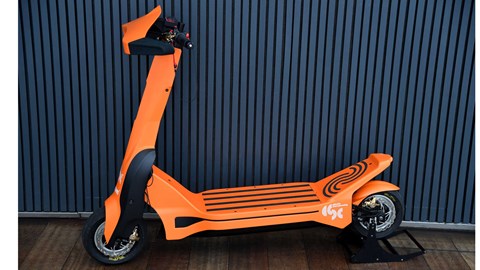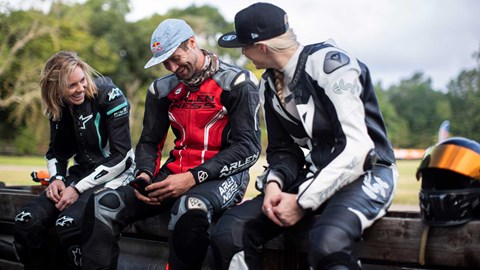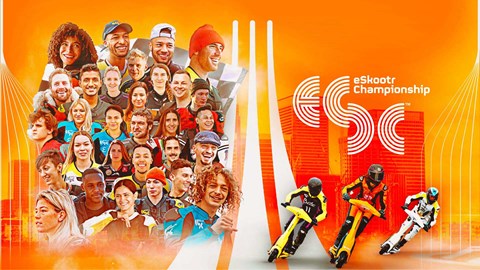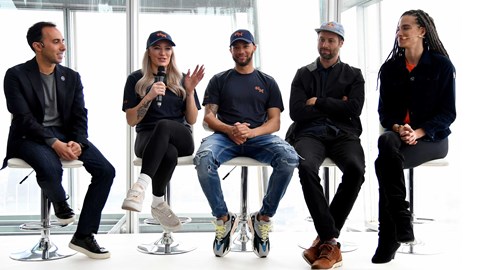► eSC is coming to the London Printworks this year
► 62mph scooters with two 6kW motors
► 30 riders and 10 teams
We’re at the launch of another new electric motorsport, and on paper it’s like every new motorsport series you’ve heard about in the last 18 months. It’s electric, it’s focused on urban mobility, and it’s designed to appeal to a younger audience. However, it’s unlike anything you’ve seen before – mainly because of the e-scooters it’ll be using…
Electric scooters?
Yes. The eSkootr championship or eSC will use all-wheel drive scooters with two 6kW motors, a 1.33kWh battery and a top speed of over 62mph. At 35kg they’re light and have enough grip to be leant at 55 degrees. We’re also told that it’s possible to torque vector too.

Take away the aerodynamic fairings and some of the power, and they’re not dissimilar to the e-scooters currently terrorizing pavements and roads across the UK’s major cities.
Each race will see 30 riders compete, across ten teams with three drivers – and they’ll be conducting a whistle stop tour of all the capital cities you’d expect. The season kicks off with the London round, which’ll take place in the Printworks venue.
Wait, isn’t there enough electric, urban motorsports around?
Yes, but like the scooters riders will be racing on, eSC has been engineered from the ground up to be light, flexible, efficient – and easily able to slot in the existing landscape. In 2022, motorsport is about the business model just as much as the spectacle, and the founders – which include Lucas di Grassi and Alex Wurz are keen to point out how efficient and sustainable eSC could be.

In the same way Formula E was pitched as a catalyst or pinnacle for EVs, eSC wants to do the same for e-scooters. But unlike Formula E and more so F1, it aims to do it in a lower-cost manner, too.
‘One way of making the business model of motorsport one to better is to make the vehicle smaller, cheaper and more accessible.’ explains former Le Mans, F1 driver, Formula E racer and eSC co-founder Lucas di Grassi. ‘And when you do that it also makes it more sustainable. So, the business idea made a lot of sense.’
Carbon-zero from inception, eSC aims to be carbon negative in the future and will be a source of R&D for future commercial products. eSC won’t have the same issues with infrastructure as other EV series such as Formula E or Extreme E, either:
‘We use local infrastructure,’ di Grassi says. ‘To charge a scooter and don’t need special charges. You don’t need to reinvent infrastructure in the city to make sure that electric mobility develops. So, it’s very convenient, very cheap.’
‘Formula E was created in 2012 to address [electric] technology in the entertainment area of the electric car market,’ explains di Grassi. ‘I saw millions of people riding scooters every day and there was no aspiration sport that you could lead into,’ he adds.

Aren’t e-scooters a bit annoying?
The founders of eSC are also aware of the negative connotations electric scooters have right now; but that’s all part of the plan; the new series will team up with cities and councils to educate as well as entertain.
‘Micro-mobility is something which is unfolding in all of our cities around the world,’ begins former F1 driver Alex Wurz, who is also a founder of the new series. ‘It’s at times a bit problematic because it’s not properly legislated. It has at times a negative image. But this is exactly like the car industry was at the very beginning.’

Will eSC work?
We’ll find out in time, but on the surface it’s a very shrewd entry into the motorsport arena. Flexible enough to squeeze into the weekends of other events (Wurz mentioned races at half-time in football matches) it’s also cheap and sustainable enough to be taken to increasingly interesting venues. And with 30 popular riders in tow, and an NFL-drafting system to for teams to get them – it has at least 30 possible chances to make an impact on social media
We’ll know more after Round 1 at Printworks London.